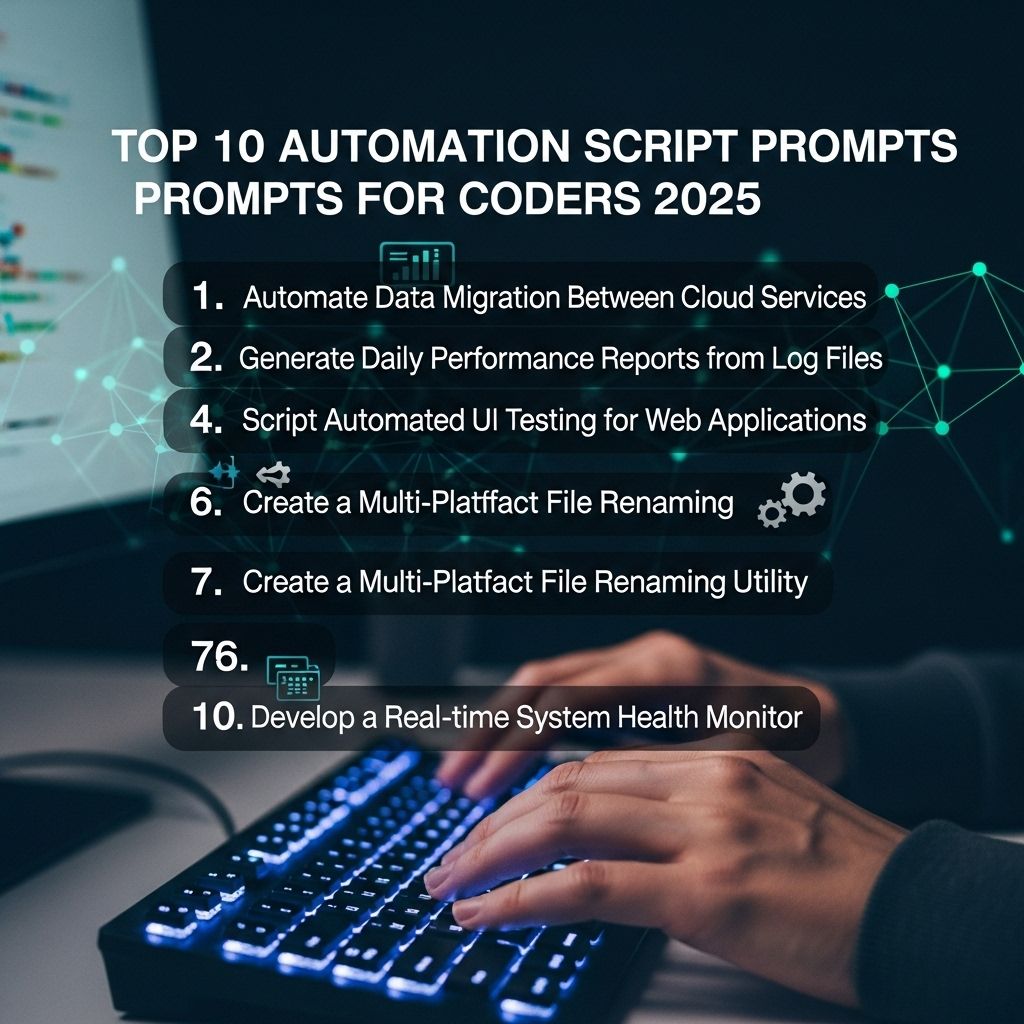In the rapidly evolving world of technology, coding has become an essential skill that empowers individuals to create, innovate, and solve complex problems. However, as the demand for faster and more efficient coding practices grows, developers are continually seeking tools and methods to enhance their productivity. One such method that has gained traction is the use of automation prompts. These prompts can significantly streamline coding processes, allowing developers to focus more on logic and creativity rather than mundane tasks.
Understanding Automation Prompts
Automation prompts are predefined commands or scripts that help automate repetitive tasks within the coding process. They can range from simple command-line instructions to complex scripts that handle extensive code generation. By integrating automation prompts into a developer’s workflow, one can:
- Reduce manual coding errors
- Increase coding speed and efficiency
- Enhance consistency across the codebase
- Free up time for more complex problem-solving
Types of Automation Prompts
There are various types of automation prompts that developers can leverage. Here are some of the most common:
- Code Snippets: Short pieces of reusable code that can be inserted into larger scripts.
- Macros: A sequence of instructions that can be triggered by a single command.
- Task Runners: Tools like Grunt or Gulp that automate repetitive build tasks.
- Code Generators: Scripts that generate boilerplate code, such as scaffolding in web applications.
Benefits of Using Automation Prompts
Incorporating automation prompts into your coding practice can yield numerous benefits:
| Benefit | Description |
|---|---|
| Time Efficiency | Saves time by automating repetitive tasks, allowing developers to focus on more critical areas of development. |
| Reduced Errors | Minimizes the risk of human error by automating routine processes. |
| Improved Collaboration | Facilitates better teamwork by providing consistent coding practices across teams. |
| Learning Opportunities | Encourages developers to learn new automation tools and techniques, improving their skill set. |
Implementing Automation Prompts in Your Workflow
To effectively integrate automation prompts into your coding practices, consider the following steps:
- Identify Repetitive Tasks: Assess your daily coding routine to identify tasks that can be automated.
- Choose the Right Tools: Select automation tools that align with your coding environment and needs.
- Create Custom Prompts: Develop your own automation scripts to address specific tasks that are common in your projects.
- Test and Iterate: Regularly evaluate the effectiveness of your automation prompts and adjust them as necessary.
Popular Tools for Automation Prompts
Several tools and frameworks can assist in creating and managing automation prompts effectively:
1. Visual Studio Code Extensions
Visual Studio Code offers numerous extensions that can help automate coding tasks. Some notable ones include:
- Snippets: Create and share reusable code snippets.
- Tasks: Automate build and test tasks using the integrated terminal.
- Prettier: Automatically format code upon saving.
2. Git Hooks
Git hooks allow you to trigger scripts before or after certain Git commands, automating tasks like code linting or running tests.
3. Jenkins
This open-source automation server helps automate parts of software development related to building, testing, and deploying, making it easier to integrate automation prompts in CI/CD pipelines.
Best Practices for Crafting Effective Automation Prompts
To maximize the efficiency of your automation prompts, adhere to the following best practices:
- Keep It Simple: Write clear and concise prompts that are easy to understand.
- Document Your Code: Ensure that your automation scripts are well-documented for future reference.
- Regular Updates: Keep your automation scripts updated to accommodate changes in your coding environment.
- Gather Feedback: Solicit feedback from team members to improve the effectiveness of your automation prompts.
Potential Challenges and How to Overcome Them
While automation prompts can enhance productivity, they are not without challenges. Here are some common issues and solutions:
1. Initial Setup Time
Setting up automation prompts may require a significant time investment initially. However, this upfront time can save hours in the long run.
2. Complexity
Automation scripts can become complex, leading to confusion. To combat this, focus on modular and well-structured code.
3. Dependence on Automation
Relying too heavily on automation can lead to a lack of understanding of the underlying code. Strike a balance between automation and manual coding practices.
Conclusion
Automation prompts are transforming how developers write code, allowing them to enhance their productivity, reduce errors, and streamline their workflows. By understanding the types of automation prompts available, leveraging the right tools, and following best practices, developers can significantly improve their coding efficiency and effectiveness. As technology continues to advance, incorporating automation into your coding repertoire is not just beneficial; it is essential for staying competitive in the field.
FAQ
What are automation prompts in coding?
Automation prompts are predefined instructions or scripts that help streamline coding tasks, allowing developers to automate repetitive actions and enhance productivity.
How can automation prompts improve coding efficiency?
By automating routine tasks, automation prompts reduce manual effort, minimize errors, and save time, enabling developers to focus on more complex and creative aspects of coding.
Where can I find automation prompts for my coding projects?
Automation prompts can be found in coding communities, online repositories such as GitHub, and through coding tools and IDEs that support automation features.
Are automation prompts suitable for beginners in coding?
Yes, automation prompts can be beneficial for beginners as they provide templates and examples that simplify the learning process and help understand coding concepts.
Can I customize automation prompts for my specific needs?
Absolutely! Most automation prompts can be customized to fit the specific requirements of your projects, allowing you to modify them as needed.
What programming languages support automation prompts?
Automation prompts are available for various programming languages, including Python, JavaScript, Ruby, and more, depending on the tools and libraries you use.




